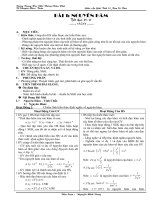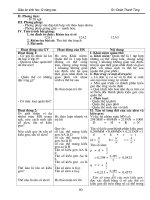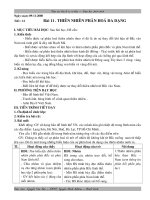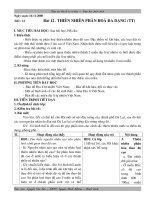GA unit12 -E 12
Bạn đang xem bản rút gọn của tài liệu. Xem và tải ngay bản đầy đủ của tài liệu tại đây (336.79 KB, 13 trang )
date of teaching: …./…../ 09
Period: 73
Unit 12 : Water sports
Reading
I. Objectives:
- By the end of this lesson, students learn about water sports and they have knowledge to play it
- Students can understand rules of playing water sports
Skills: - Guessing meaning from context
- Passage comprehension
- Reading for specific information
II. Method: Integrated, mainly communicative
III. Teaching aids: textbooks, some pictures of water sports
IV. Procedure:
Teacher’s activities Students’ activities
Warm-up: (5 minutes)
- Hangs up 2 pictures of water sport and
football
- Asks some questions:
1. What kinds of sports are in the pictures?
2. Where can people play these sports?
3. How do people play them?
4. Which sport do you think is more popular?
- Leads in new lesson: Water sports
Before you read : (7 minutes)
- Ask students to close the books
- Shows 2 pictures and says: the sport in
picture A is “water polo” and in picture B, the
read team plays against the white team, so the
red one is the “opponent” of the white one.
- Explains some new words if necessary
Water polo (n) : Môn bóng nước
- Tie (n) : Trận hoà
- Vertical (a) : Phương thẳng đứng
- Foul (n) : Phạm luật , sai sót
- Oppenent (n) : Đối thủ , đối phương
- Penalty (n) : Hình phạt
- Eject (v) : Đẩy ra , tống ra,đuổi ra
- Goalie (n) : Người giữ khung thµnh
While you read : (23 minutes)
- Asks students to open the books and read the
passage silently
- Lets students do task 1
Task 1 :
- Asks students to do the task individually then
- Look at pictures and answer all the
questions
- Answer freely
There are a large number of sports that
involve water
- Look at pictures and guess meaning
of 2 new words
- Listen to the teacher and write down
compare answers with partner
- Checks answers with the whole class and
gives feedback
Task 2:
- Asks students to do the task in pairs and read
scan the passage to find information in the text
to fill words in the blanks
- Goes round to give help
- Checks answers and give feedback
Task 3:
- Ask students to find answers for all questions
in the passage individually first, then compare
in pairs
- Calls some students to present their answers
in front of the class
- Listens to the students and corrects mistakes
- Calls on some students to write answers on
the board
- Corrects mistakes again
After you read : (8 minutes)
- Divides the class into 2 groups: one talks
about football and another talks about water
polo
- Asks students to do as the table in textbook
- Maybe asks students some questions:
1. Would you like to try water polo? Why or
why not?
- Read individually
- Do the task independently
Key:
1. e 2. c 3.a 4.b 5.d
- Work in pairs and do the task
Key:
1. 18 ; 30 metres; 20 metres
2. white caps; blue caps; red caps
with the number 1 in white.
3. Their own goal lines.
4. Holding or punching the ball.
5. Five to eighty minutes.
- Do independently first then work in
pairs
- Present answers in front of the class
and correct in notebook
Key:
1. People can play it in a pool.
2. It is in the centre of the pool.
3.The ball can be advanced by passing
with one hand or swimming with the
head above the water and the ball
between the arm so it rides on the
wave create by the swimming s head’
4. Only the goalie can hold/ is allowed
to hold the ball with both hands.
5. The player is ejected after
committing five personal fouls.
- Work in 2 groups
- Do the task
2. Do you think it’s more or less dangerous
than football or other sports? Why?
- Goes round to help
- Calls each group to present
- Gives comments
* Compare the both sports
FOOTBALL WATER
SPORT
Place to play On the ground In the water
Number of
players
11 07
Main rules Ball Ball
Length of the
game
90 minutes
Home work: (2 minutes)
- Asks students to write a paragraph about
ideas of water polo (about 100 words)
- Asks students to prepare part B. Speaking at
home
- Representative of each group
expresses the own ideas in front of the
class
- Listen to their friend’s talking and
give comment
- Listen to the teacher and write down
Water polo is a team water sport. A team
consists of six field players and one
goalkeeper. The winner of the game is the
team that scores more goals. Game play
involves swimming, players passing the ball
while being defended by opponents, and
scoring by throwing into a net defended by a
goalie. As such, water polo has similarities to
association football (soccer) and netball.
In the water
• Swimming includes pool swimming and open water swimming
• Triathlon is usually a combination of swimming, cycling and running
• Modern pentathlon includes épée fencing, pistol shooting, swimming, a show jumping course on horseback,
and cross country running
• Rescue swimming is swimming with the goal to rescue other swimmers or the practice thereof
• Water polo is a team sport played in water.
• Synchronized swimming is a hybrid of swimming, gymnastics, and ballet.
• Water aerobics is aerobics in the water
• Water gymnastics is gymnastics in the water
• Snorkeling is the practice of swimming at the surface (typically of the sea) being equipped with a mask and a
short tube called a snorkel.
• Diving off springboards or off platforms
• Synchronized diving
• A water slide is a slide with water flowing down it
Swimming is an amazing sport. It is fun and amazing for your whole body. Swimming can build up endurance and is
great for physcial therapy and your heart. It is a great way to get you moving and feeling good.
Under water
Main article: Recreational diving
• Scuba diving is swimming under water using a (self contained) breathing apparatus
• Free-diving is the aim to maximize the depth dived using no breathing apparatus
• Underwater hockey is hockey played under water with short wooden curved sticks and a heavy puck. Players
wear diving masks, snorkels, and fins, and must surface to breathe while team mates continue the game on the
pool bottom.
• Underwater rugby is rugby played under water. Two teams try to score goals by sending a slightly negatively
buoyant ball into the opponents' goal, which is situated on the bottom of the pool.
• Underwater photography is photography done under water. Numerous contests worldwide are arranged every
year. The digital cameras have revolutionized how many divers participate.
On the water
Main article: Surface water sports
• Skurfing is where the participant "skurfs" behind a boat on a surfboard
• Barefoot water skiing is waterskiing with no skiis
• Boating is the use of boats
• Bodyboarding is similar to surfing, but the board is smaller and the person (normally) lies down on the board
• Canoeing
• Fishing is the recreation and sport of catching fish
• Jet Ski
• Kayaking
• Kite surfing on flat water using a kite for propulsion
• Parasailing where a person is towed behind a vehicle (usually a boat) while attached to a parachute
• Rafting
• Rowing
• Sailing using the wind for propulsion
• Skimboarding is a boardsport in which a board is used to ride on an incoming wave.
• Stand Up Paddle Boarding a surf style board with a paddle, used in flatwater or waves
• Surfing downhill on ocean waves or artificial waves in an artificial wave pool
• White Water Rafting
• Wakeboarding is similar to water skiing, but using only one board attached to the feet
• Wake skating is similar to wakeboarding, but the board is not attached to the feet
• Water skiing is using skis to slide over the water while being pulled by a boat or other device
• Windsurfing on flat water using wind for propulsion in combination with sails
• Yachting sailing on yachts, daysailing, cruising or Yacht racing
date of teaching: …./…../ 09
Period: 74
Unit 12 : Water sports
SPEAKING
I. Objectives:
By the end of this lesson, students can talk about some water sports that they prefer
Students learn about some water sports
Skills: - Talking about types of water sports
- Giving opinions and preferences about water sports
II. Method: integrated, mainly communicative
III. Teaching aids: pictures, textbooks
IV. Procedure:
Teacher s activities’ Students activities’
Pre- speaking: (5 minutes)
- Ask students to keep book close
- Says: “In just one minute, look at
the pictures and write down on a
piece of paper a list of equipments
which are used to play with these
types of water sports”
- Asks students to work in groups
- Calls some groups to speak their
answers
- Declares the winner
While-speaking : (15 minutes)
- Scuba – diving (n): lặn có bình khí
- Windsurfing (n) : lướt ván buồm
- Rowing (n) :
- Synchronizeed swimming (n): bơi nghệ thuật
- Fins (n) :
- Regulator (n) :
- Wet suit (n) :
Task 1
- Ask students to look at pictures and
match names of equipments with
names of water sports and retell
names of each sport
- Calls some students to speak
- Correct pronunciation
Task 2
- Asks students to look at the table
and talk about each type of water
sports
- Lets students do individually
- Goes round to check their activities
- Calls some students to practise
speaking model conversations
- Asks students practise in pairs
- Keep books close
- Listen to the teacher
- Look at the pictures and try to tell some equipments
of water sports (ex: ball, air tank, mask, fins, oars, boat, board,
regulator, wet suit, sail ect. )
- Look at pictures and try to remember
- Correct pronunciation themselves
1. Swimming 4. Windsurfing(on flat water using wind for
propulsion in combination with sails)
2. Water polo(is a team sport played in water.) 5. Scuba- diving
3. Synchronized swimming
6. Rowing
- Look at the book
- Work independently
- Practise speaking with the teacher
- Work in pairs
- Listen to their friends
- Work in small groups
- Listen to their friends and gives comments
- Listen to the teacher
Type of sport Place Equipment required to
play with
Number of players/
participants
Water polo Pool Ball team
Rowing Sea,
lake,
river
Boat, oars Individually, team
Windsurfing Sea,
lake
Board, sail individually









